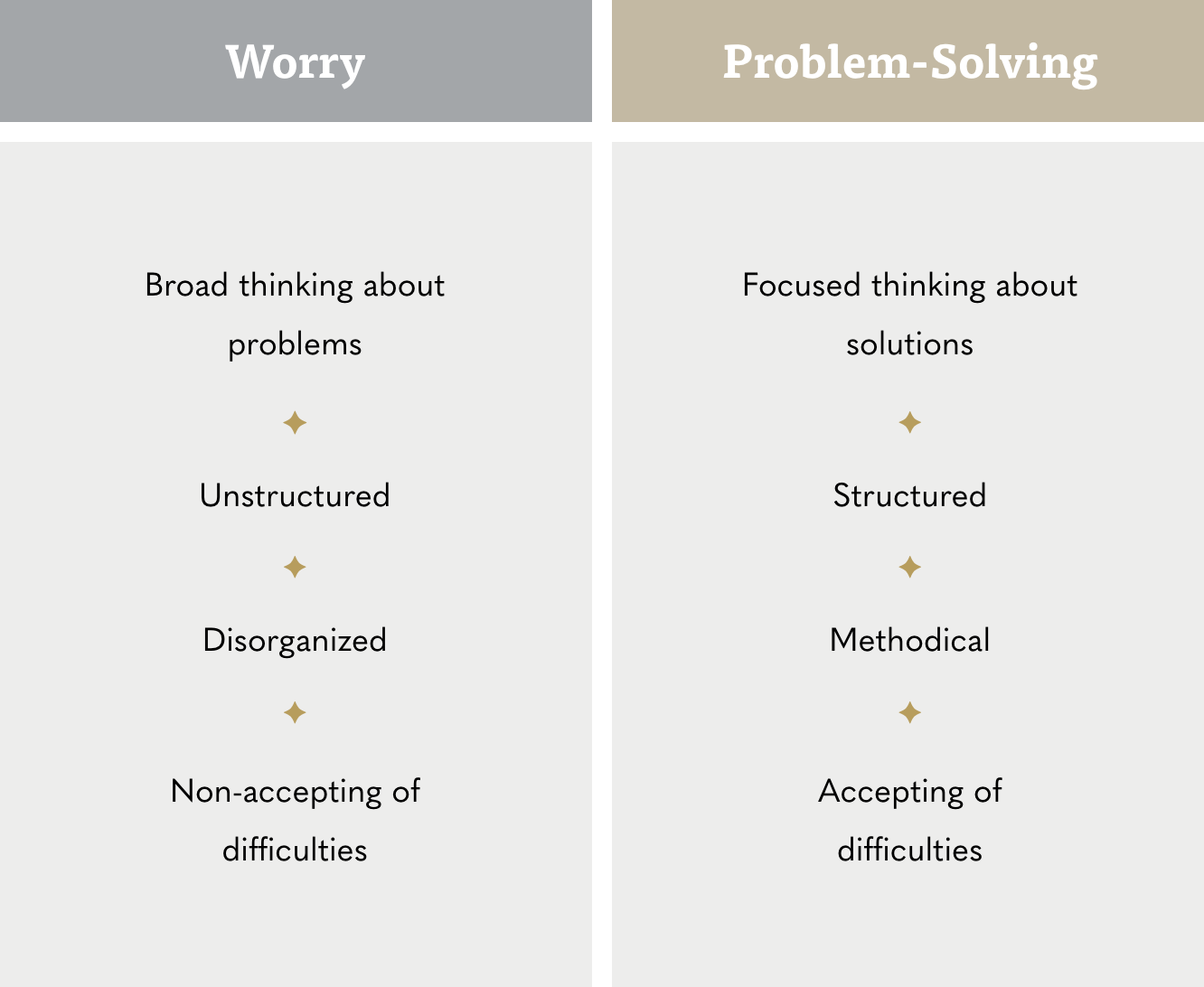Worry is a strange companion. It can paralyze your body while also convincing you that it’s the only thing keeping you safe. You feel trapped and tense while it frantically searches for some solution that will allow life to return to normal.
And perhaps, in some way, you’ve grown attached to it. Worry promises certainty. It offers protection and shields against the unknown. But for all the discomfort it brings, what does it truly give you in return? Does it offer peace, or only the illusion of protection that leaves you no better prepared?
KEY TAKEAWAYS
- Worry vs. Problem-Solving: Worry is a disorganized reaction to uncertainty that fixates on problems, while problem-solving is a proactive, structured approach that seeks solutions.
- Worry as a Coping Strategy: People often use worry to gain certainty, avoid discomfort, or prepare for worst-case scenarios. However, these strategies are exhausting and prevent real emotional processing.
- Breaking the Cycle of Worry: Recognizing when worry is being used as a coping mechanism allows you to shift toward problem-solving or move on with acceptance.

HOW ANXIETY HIJACKS RATIONAL THOUGHT
The Difference Between Worry and Problem-Solving
The biggest issue with relying on worry as a strategy is that, despite you feeling productive and engaged, it's nearly the exact opposite of true problem-solving! It leaves you no better prepared to deal with your issues and no more confident in your abilities to actually handle them well.
The difference:
Worry is a reactive defense focused on problems rather than solutions.
Problem-solving is a proactive approach that includes accepting challenges and working through them.
Worry is a broad, automatic reaction to uncertainty but lacks the structure and focus of problem-solving.
This is why its presence is disorganized rather than methodical in moving your forward.

Think of it like this — Imagine you're trying to find something really important on a messy and cluttered desk:
► Worry is like frantically shuffling through stacks of paper, scanning them over and over, hoping what you're looking for will jump out at you.
► Problem-solving is like sitting down, organizing the papers, and methodically working through them to find what you need.
Problem-solving allows for natural uncertainties — worry does not.
Problem-solving accepts that some difficulties can't be completely resolved in order to work around them.
Worry, on the other hand, refuses to accept ambiguity and keeps you trapped in a cycle of overthinking.
In fact, the ultimate solution may be to accept that there's no way to be certain about an upcoming situation and you can continue on with your life anyway.

THE FUNCTION BEHIND THE MENTAL NOISE
Why Do We Use Worry as a Coping Strategy?
1. Using Worry to Gain Certainty
If you’re the type of person who often needs to have all of the information about something ahead of time, or you get stuck and unable to move on without having all of your questions or concerns answered, you’re likely dealing with an intolerance of uncertainty.
Your brain interprets missing or ambiguous information as too negative to ignore and gets stuck trying to fill in the blanks.
But here’s the reality: Some uncertainties can’t be resolved ahead of time. They must be accepted, lived through, and figured out in the moment.
Procrastination, reassurance-seeking, over-planning, and getting spun up are all more likely to happen if you can't tolerate uncertainty.
2. Using Worry to Avoid Discomfort
Worry isn’t just about looking for answers, it’s also about avoiding difficult feelings. By inhibiting brain areas associated with emotional processing, worry may allow you to avoid experiencing distress.
The problem? You have finite energy to regulate your thoughts and feelings, and worry is exhausting! It’s not a workable long-term strategy.
Suppressing emotions doesn't make them go away — it makes them stick around longer.
3. Using Worry to Brace for Impact
Sometimes, worry isn’t about seeking answers or avoiding emotions — it’s about preparing for the worst. This kind of worry keeps you in a state of hyper-vigilance so that if something bad happens, you won’t feel as shocked.
Think of it like stepping into a hot shower:
- If the water suddenly turns hot, it's painful!
- If you gradually increase the heat, it's uncomfortable but not jarring.
Worry works the same way: It tries to avoid the sharp contrast that goes from being calm to suddenly stressed. By keeping you constantly on edge, you never have to experience a sharp spike in anxiety.
Increasing your distress to avoid being caught off guard prevents true peace of mind.

INTERRUPTING THE PATTERNS THAT FUEL ANXIETY
Breaking the Cycle of Worry
Take some time to reflect on whether any of these reasons resonate with you:
Are you using worry to gain certainty where it can't be had?
Are you using worry to avoid emotional discomfort?
Are you using worry to brace yourself for catastrophe?
If so, start by catching that you're doing it and knowing why you're doing it. Then shift from worry into action.
- Engage in true problem-solving. Rather than spin on worried "what ifs," really ask yourself - what if? What will I do if this future scenario happens? And what's one small, concrete step I can take right now that moves me forward?
- Practice emotional acceptance. Remind yourself: I can handle discomfort, and I don't need to control this. I'm getting better and better at being with the uncertainty.
- Interrupt the worry cycle. If you notice yourself mentally spinning, consciously redirect your focus to something else. Rehearse: Thank you, mind, for trying to help me. This doesn't need more of my attention, and I can move on with my day.
STARTING WITH AWARENESS
Seeing Worry for What It Is
Worry feels productive, but it rarely solves anything. Instead, it keeps you mentally exhausted and stuck, convincing you that you must keep thinking to be safe.
It's not easy to stop the cycle, but simply noticing that you're worrying — and understanding why — starts putting you back in control. From there, you can decide whether the situation needs real problem-solving or if you need to move on.
It takes practice, but over time, you'll continue to improve.




